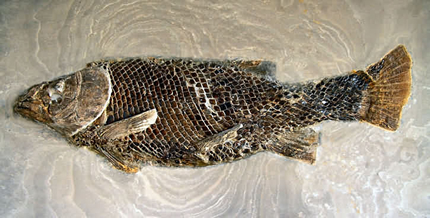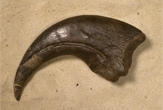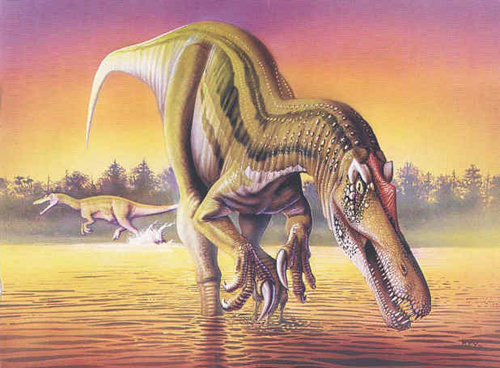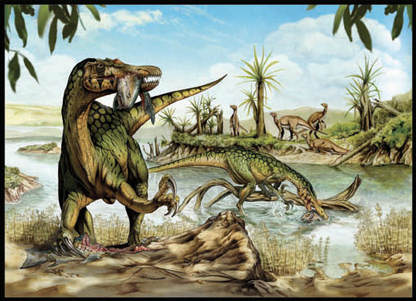Baryonyx walkeri - European Dinosaurs
Homepage > European Dinosaurs - Baryonyx walkeri
(bare-ee-ON-iks)
"heavy claw"
Describer Charig and Milner, 1986
Also Known As Suchosaurus? Owen, 1841. Suchomimus? Sereno et. al, 1998
Type of Species walkeri
Order Saurischia
SubOrder Theropoda
InfraOrder Tetanurae
Micro-Order --
Family Spinosauridae
Size 33 feet (10 meters) in length
Period Cretaceous Early Barremian
Fossilsite Wealden Beds, Smokejacks Pit, Ockley, Surrey, England
Diet Bipedal Carnivore
Baryonyx walkeri was a bipedal carnivore. This dinosaur obtained its name from the long, curved claws on its thumbs. It is believe that this dinosaur was a fish eater, since remains of a partially digested fish were found inside its ribcage. Up to this date Baryonyx is the only known dinosaur that ate fish. The remains of the discovered fish found inside Baryonyx belonged to a big fish known as Lepidotes. This fish is known to have grown as big as 3 feet (1 meter) in length. Below is an image of a fossilized fish, Lepidotes.
 Perhaps this dinosaur capture its prey the same as modern mammals do nowadays,
such as the bear. Using its long sharp claws this dinosaur possessed the
ability to grasp the slippery fish. Or possibly it scooped fish out of
the water, as modern crocodiles do. There is also the belief that Baryonyx
was a scavenger.
Perhaps this dinosaur capture its prey the same as modern mammals do nowadays,
such as the bear. Using its long sharp claws this dinosaur possessed the
ability to grasp the slippery fish. Or possibly it scooped fish out of
the water, as modern crocodiles do. There is also the belief that Baryonyx
was a scavenger.
Baryonyx possessed a narrow skull that was packed with about 96 small, sharp teeth. It had a long snout, similar to the modern crocodiles.
 Baryonyx
had two powerful arms, it had three fingers on each hand. There was a
long curved claw on its inside fingers (thumbs). In a fully grown adult,
the claw was 1 ft 2 in (35 cm). The image to the left shows the impressive
size when compared to a human hand. Impressive size for a thumb nail.
Baryonyx had a long straight neck, which was unusual for large carnivores.
Most of the carnivores of its time possessed necks shaped like an "S".
It also possessed a long straight tail, which assisted with balance.
Baryonyx
had two powerful arms, it had three fingers on each hand. There was a
long curved claw on its inside fingers (thumbs). In a fully grown adult,
the claw was 1 ft 2 in (35 cm). The image to the left shows the impressive
size when compared to a human hand. Impressive size for a thumb nail.
Baryonyx had a long straight neck, which was unusual for large carnivores.
Most of the carnivores of its time possessed necks shaped like an "S".
It also possessed a long straight tail, which assisted with balance.
Discovered Species
Baryonyx walkeri
Baryonyx tenerensis
Discovery
Baryonyx was discovered by a claw that was unEarthed in 1983
in a clay pit in Great Britain by an amateur fossil hunter, William Walker.
This clay pit is located in Surrey, in southern England. When the claw
was reveled to the Natural Museum in London, England, they realized that
this was a major find. A team of eight paleontologists from the museum
spent three weeks searching for more remains of the creature.
Baryonyx walkeri Paleo Gallery
Click on images to see more art from artist!

